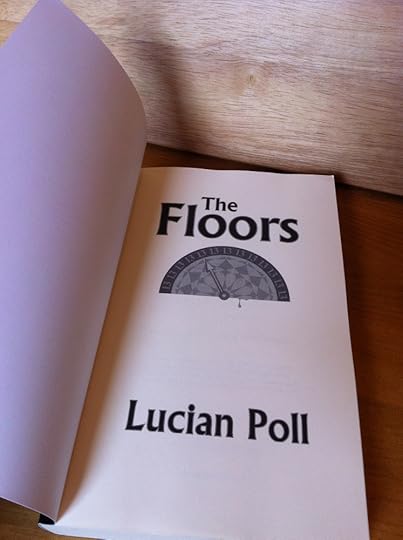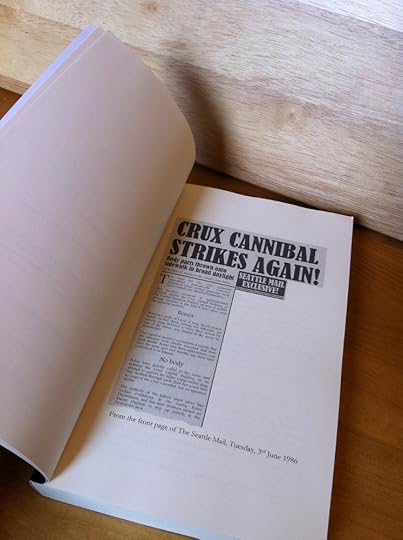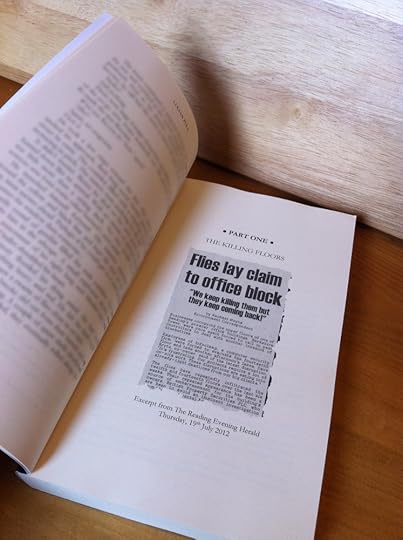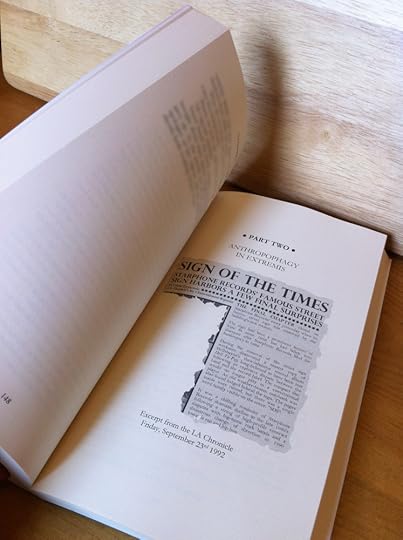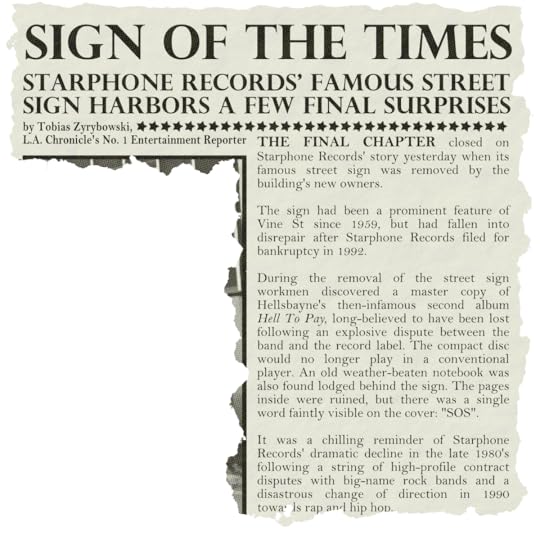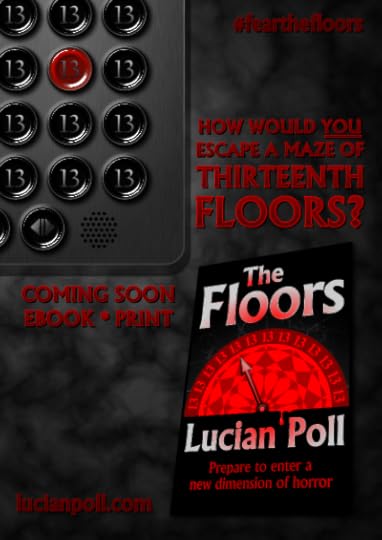Lucian Poll's Blog, page 41
October 6, 2013
Publishing via Smashwords – A How-To…
Last year I posted a short series on how to go about publishing something via Amazon’s Kindle Direct Publishing platform. (You can access these posts, and others you may find useful in my Setting Up page.)
This is a somewhat overdue post that details the process you can expect to complete when publishing something using Smashwords, which is a popular publishing platform that offers exposure to a number of eBook platforms other than Kindle, such as Apple’s iBookstore.
This post assumes you have already set up an account with Smashwords and have two files handy: a correctly-formatted manuscript file and a JPEG or PNG image for your cover. (Seek out and download the Smashwords style guide on their website for guidance on how to format your manuscript. It’s damn near invaluable and the best practices preached within will serve you pretty well for other eBook publishing platforms.) (The cover image needs to be pretty high-res; the suggested minimum size being 1400 pixels wide by 2240 tall.)
So let’s give this a whirl. I have a .DOC file for my novel, The Floors, and a 1400 x 2240 PNG cover image, a thumbnail of which you can see on the right. Given these I should now be able to get some publishing done.
(NOTE: The following was composed 5th September 2013. If you are reading this while scraping a living on the radiation-blasted wastelands of 23rd Century Washington DC then the process may have moved on a little. But, hey, at least you’ve still got your health, right?)
Once logged into Smashwords you will see in the menu bar an option to ‘Publish’. Clicking on this will initiate the publishing process, comprising of eight fairly straightforward steps that run down the page.
Step 1: Title and Synopsis
There are a number of things to input here.
i) The first is the title of your book – fair enough.
ii) A newish feature of Smashwords allows you to publish a book and make it available as a pre-order. As The Floors was advertised with a release date of Friday 13th September 2013, that was the date I entered. (You can also publish the book straight away if needs be.) When creating a book for pre-order you are encouraged to specify a publishing date 4-6 weeks in advance. This is to allow the necessary time for your book to be approved by the various platforms fed by Smashwords. There is an added benefit to creating a lengthy pre-order period in that your book is persistently retained towards the top of the relevant categories on Smashwords’ site, though I can see this exploit being abused left, right and centre in the not-too-distant future.
iii) Next you need to enter a short synopsis of the book. This is the description browsers of Smashwords will see, so it needs to be short and punchy. No line breaks are allowed and you have only 400 characters to grab the reader’s attention.
iv) You then have an optional text box where you can enter a longer description of your book for those interested to read more.
v) Finally you can select the language of your book. Even though the book is written with a distinct British twang I’ve kept the language to the default: “English (dialect unspecified)”
Step 2: Pricing
Here you get to demand people’s hard-earned cash for the privilege of devouring your words… should you wish. You see, unlike Amazon’s KDP platform, Smashwords allows you to give your story away for free. (This is a popular strategy to help sell a series of books, where the author lets people read the first book for free.) If you decide to charge for the book, however, then it must fetch a minimum price of $0.99.
As mentioned in previous blog posts I decided on a $2.99 cover price for the eBook. (Note you cannot dictate prices in other currencies like you can on Amazon KDP and CreateSpace.)
Finally, you can also dictate the percentage of your book to offer as a sample. The default is 20%, but I scaled this back to 15%, which, if my calculations are correct, leaves the story hanging at a very teasing point!
Step 3: Categorization
Here you can select a primary category and an optional category for your book. Browsers of Smashwords can navigate the sidebar to get to the kind of books they like. This section allows you to specify the location(s) in which your book can be found. Given that The Floors is a sci-fi horror novel, I selected:
Fiction => Horror => General, and
Fiction => Science Fiction => General
You are also asked to declare any adult content within your book. While The Floors is peppered with industrial language and violent scenes, I’m reluctant to declare its adult content as, to me, that’s lumping it in with the frankly staggering amount of sweaty, questionable porn that other Smashwords authors – er – ejaculate on a minute-by-minute basis. That said, I don’t want to find my bollocks in a vice for breaking the rules, so I’ll tick the box and keep my fingers crossed readers can still find me, drowning in a swamp of stepdaddy grot and college girl cream pie action.
Step 4: Tags
Here you can enter a bunch of keywords that all relate to your book. They help browsers search for books that interest them. I’ve kept mine fairly simple, being:
Fiction, Novel, Horror, Sci-fi, Science fiction, The Floors, Thirteen, Thirteenth floor
Step 5: Ebook formats
Here you can select the file formats you would like to offer readers of your book. Your best bet here is to upload a Word document (.doc), as it pretty much opens up every eBook format available. If your book is heavy on the graphics, however, then you may want to explore the options here a little more. A graphic novel in TXT format may not go down too well unless you are some master ASCII artist!
Step 6: Cover image
Here you select the image to upload for your book. As mentioned earlier, a JPG or PNG file of 1400×2240, or larger, is recommended.
Step 7: Select file of book to publish
Here you select your manuscript file. Don’t upload a .docx file (i.e. Word 2007 onwards), as the Smashwords meatgrinder will spew it out. Chuck in a well-formatted .doc file (i.e. Word 97-2003) and you should be okay. Again, read and adhere to the Smashwords’ Style Guide before uploading a file. There are likely some things in there that will improve your overall word processor skills.
You should also make sure your document contains the correct information on the copyright page. See Smashwords’ FAQ page for their current suggested wording: https://www.smashwords.com/about/supportfaq#troubleformatting
Step 8: Publish
Easy peasy. This is basically you hitting the “Publish” button. By doing so you will agree to Smashwords’ terms of service, will allow distribution to partner sites (e.g. Apple’s iBookstore) for the price you have set, and to allow users to sample your work as dictated in the settings you configured earlier.
Once you hit ‘Publish’ you’ll be met with a page displaying the current progress made converting your book into the assorted formats you chose. When this is done you will be informed of any errors in your document. These will all need to be corrected to ensure the widest distribution possible, so it’s worth your while exploring each error thrown your way. Note that you can upload newer, corrected versions of your book via your Smashwords Dashboard. You can also download a free copy of your book in assorted formats to check how they look. Very handy indeed!
Your magnum opus will appear on your dashboard with a Premium Status of “Under Review”, even if it contains errors. I can’t fathom why Smashwords would do this as uploading a corrected document serves only to start the review process afresh, but there you go. Once your book has been cleared, and you have specified an ISBN for it, then it will be deemed fit for Smashwords’ “Premium Catalog”‘ and uploaded to assorted eBook platforms. (After my recent review of ISBNs I opted for a free ISBN from Smashwords.)
So there you have it, folks: a whistlestop tour of Smashwords publishing. (You can see the finished article here.) Now all you need to do is the hard bit: writing something upon which you’d feel proud to slap your name, he says pseudonymously. 
Laters, taters!
Tagged: ebook, publishing, smashwords








September 13, 2013
Welcome to The Floors!
Hello, peeps! It’s your least humble servant, Mr Poll, here again, this time with a rather special blog posting. Well, it’s special from this side of the keyboard, anyway!
Just over a year ago, on July 19th 2012, I had this bizarre story idea about being trapped in a maze of thirteenth floors. As ideas went I knew it was a good one, but I wasn’t prepared for what happened next. Plot lines, scenes, locations, characters, possible finales - they all flooded out. I couldn’t sit down for pacing the house. My brain wouldn’t stop. Piece after piece of the story fell into place at such speed that I could barely keep up. I was awake ’til five in the morning scribbling notes. I knew I could never sleep properly again until the idea was fully out of my head and onto paper.
Fast forward 60 weeks and I am delighted to say I can finally go to bed! Yes, folks, The Floors has been unleashed upon the world, and all the gory details can be found below.
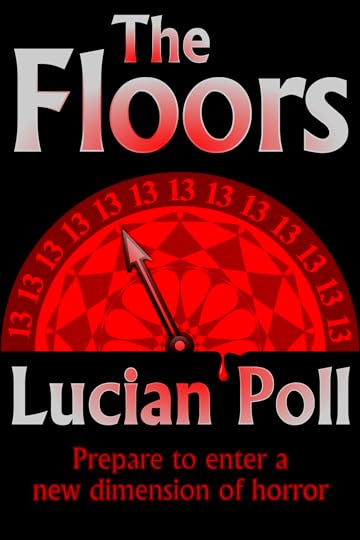 HOW WOULD YOU ESCAPE A MAZE OF THIRTEENTH FLOORS?
HOW WOULD YOU ESCAPE A MAZE OF THIRTEENTH FLOORS?You work in a skyscraper.
You live in an apartment block.
You stop over at a hotel.
You find a button missing from the elevator’s control panel.
Thirteen.
Over the years superstition has robbed floors from thousands of buildings across the world, and continues to do so.
Dawn McKenzie and Joe Bradley are about to discover where these floors really lie. Chased into an impossible maze split across time and space, their chances of survival narrow by the second.
And in a maze with precious little food, they are not the only ones trying to survive…
THE FLOORS is available for purchase via the following links. I’ll update this post as further links become available. (See also the dedicated page for The Floors, accessible via the menu bar, above.)
EBOOK versions - $2.99 (approx €2.60 / £1.95)
Amazon: US UK CA DE FR ES IT
(Alternatively search for “Lucian Poll The Floors” in your local Amazon store.)
Smashwords: https://www.smashwords.com/books/view/354409
Apple iBookstore: (Link forthcoming.)
Kobo: (Link forthcoming.)
Barnes & Noble: (Link forthcoming.)
Sony: (Link forthcoming.)
PRINT versions – $13.99 (€11.99 / £9.99)
Amazon: Link forthcoming. (Expected availability from 20th September 2013)
CreateSpace: https://www.createspace.com/4091315
Other links
You can also find The Floors on Goodreads via this link: http://www.goodreads.com/book/show/18463346-the-floors
If you are a Goodreads member be sure to enter the giveaway for a chance to win one of three signed copies. The giveaway ends on Halloween and there are already rather a lot of entrants, so good luck!
If you want to get in touch via Twitter, or if you want to read my occasional witterings from time to time, you can find me via @LucianPoll. You can also use the #fearthefloors hashtag, which I check from time to time. Finally, you can give thumbs to the Facebook widget on the sidebar for news and updates on The Floors as I post them.
So there you have it – Mr Poll’s debut novel is finally out there in all of its gory glory. Do check it out. If you liked The Floors then please recommend it to those you think would also enjoy a read. If you bought the print copy then feel free to lend it on. Word-of-mouth recommendations are the lifeblood of fledgling writers, and every one of them is really appreciated!
I’ll leave this post up for a few weeks while my print adverts are doing the rounds, and then I’ll be back with a How-to guide on Smashwords publishing and a few other odds and sods you may find of interest.
Thanks for reading!
Tagged: books, horror, novel, the floors, thirteen, writing, XIII








September 3, 2013
A sneaky preview of The Floors, you say? Oh, go on then!
Well, it’s taken a long, long time, four drafts, five test readers, a professional edit and around a bazillion read-throughs but it’s done! It’s finally done!
The Floors is ready to rock n’ roll.
It’s swallowed up a laptop, condemned my central heating, stolen my sanity, driven one’s better half to despair and has even made my editor ill. (The content of the story may have had a bearing on that.)
Frankly, after all that, I think it’s high time I unleashed it on you all, and on Friday 13th September 2013 that’s exactly what I plan to do. You’re welcome, world! Moo ha-ha-ha-haaaaa!!!!
 In the meantime, if you’d like to know what you’re letting yourself in for, then you’re in luck! I just so happen to have a sneaky 3-chapter preview of The Floors and it’s all yours. Here you go:
In the meantime, if you’d like to know what you’re letting yourself in for, then you’re in luck! I just so happen to have a sneaky 3-chapter preview of The Floors and it’s all yours. Here you go:
PDF: The Floors – Final Draft (3 chapter sampler)
Note: As should be obvious from the cover, The Floors is a horror novel, so expect violence and big swears from the outset.
If you like the cut of this sampler’s gib then you can buy the whole darned thing a week on Friday in eBook format or as a rather swish paperback.
Give the blog a follow, or give the Facebook page some thumbage, and I’ll keep you abreast of all you’ll need.
In other blatherings, please accept my apologies for being MIA these last few weeks. The findings of the test reads and the professional edit necessitated a few repairs and improvements to the story. The next post will be for the big launch. After that I’ll be back with a few posts on my experiences in getting this far and no doubt a few other odds and sods in the run-up to the World Fantasy Convention and, of course, NaNoWriMo 2013.
Keep it scary, people!








August 11, 2013
Review – Expedition to the Mountains of the Moon
 Note: This review first appeared on my Goodreads page.
Note: This review first appeared on my Goodreads page.
Everyone likes to find a twenty in their wallet they forgot they had. Nestled between some wrinkly old receipts, its discovery puts a smile on your face and you find yourself saying “Hello, where have you been all this time?”
I found the final three-quarters of Expedition to the Mountains of the Moon a little like that, for reasons I’ll blather about shortly.
Welcome to the by-now utterly bizarre universe occupied, amongst others, by Sir Richard Burton, famous explorer and agent for King Albert (see, bizarre – I told you), and his assistant, the poet Algernon Swinburne. Theirs is a time knocked wildly off-course by the accidental interference of one Spring-Heeled Jack, whose inadvertent influence has given science and technology a premature shot in the arm, leading to bizarre insect-based conveyances (each hollowed out and steam-driven) and eugenically-altered plant life. So, yeah, like I said… mondo bizarro.
It should be said at this point that you really ought to come to Expedition to the Mountains of the Moon having already read The Strange Affair of Spring-Heeled Jack and The Curious Case of the Clockwork Man. While Hodder gives the reader a fair amount of backstory, had I have come to this book cold I’d have perhaps put it down three chapters in, wondering what in blue blazes was going on, and declaring the whole thing a little too wilfully outré.
A significant reason for this, as I alluded to earlier, is because the universe in which these stories take place has, by book three, deviated so far from historical norms as to make it almost alien. The creative spurts of the eugenicists, for example, has bridged the gap to create not only animal men, but plant men too. Weaponised vegetation? Check. Acid-spitting plant-life with a thirst for blood? You betcha. In the first book, Spring-Heeled Jack suffers severe culture shock upon landing so far back in the past, which, I suspect, is a sensation not entirely dissimilar to diving into this series three books in.
The most troubling aspect I’d have had, however, would have been the structure of the book. Here you have two Burtons: one preparing to venture to the Mountains of the Moon, to not only retrieve a dirty great diamond but also to once and for all ascertain the source of the Nile; and also a second amnesiac Burton flung forward in time to an alternate World War I, witnessing first-hand the terrible world that has spun off from the actions of both Spring-Heeled Jack and he himself.
In short, I suspect it’d make a hell of a lot more sense if you were to read the first two books, so off you toddle.
For those of you still here, let me say that Expedition to the Mountains of the Moon is another great read from Hodder, who, I’m guessing, three books in, is having a whale of a time conjuring up yet more complicated oddness for his alternative universe, when most lesser writers would have jumped off a bridge, declaring to have written themselves into a corner.
Not only has Hodder an imagination seemingly only measurable in light years, but he has a depth of knowledge for the Victorian era to match it. While his universe has spun off in many bizarre ways following the accidental assassination of Queen Victoria, it still recognisably parallels real-life events and the people of the age. But then, in Expedition, he pulls an ace from his sleeve.
We are shown, in the previous books, Burton’s recollections of his time spent in Africa, and how he incorporates the things he learned there into his day-to-day duties as the King’s agent. These references help cement the man as a dyed-in-the-wool explorer. Around a quarter of the way into Expedition, Burton and company embark on their journey for the final as-yet undiscovered black diamond, and here Hodder suddenly reveals himself to be just as good at writing a sprawling (and, crucially, well-researched and expertly-executed) desert adventure. After 2 1/4 somewhat barmy books set in foggy old Blighty I found myself reading Expedition thinking “Hello! Where’s all this come from? This is great!” It was like finding a whole new book, if not that crisp twenty from earlier.
Expeditions is not a book without its issues, however. Like Spring-Heeled Jack before it, the reader is asked to let slide some pretty eye-watering coincidences from beginning to end. For example, the way in which Burton’s party for the expedition is assembled is somewhat contrived (i.e. nearly all the surviving characters from the previous book are somehow shoehorned into the start of the expedition, including one that instantly had my eyes rolling – you’ll know who when you get there). An old returning character is reintroduced to the story in a fashion that had me saying to myself “Of all the oases in all the deserts in all of Africa she walks into mine”. Finally, the author’s habit of dropping in real-life historical figures into the story continues unabated. Some work, such as Sidi Bombay, while others set my eyes rolling again.
Finally, there were a few too many typos than one would expect from a retail book. There are thankfully not as many as there were in Spring-Heeled Jack, but enough that had me starting to watch out for them, taking me out of the story a little.
As for the ending… well, let’s just say I can’t wait to read #4, if only to see how on earth Hodder manages to continue the story. The Goodreads blurb hints #4 to be the start of a new series, which sounds ominous. I’ll reserve judgement, however, until I get my eager peepers on the thing.
Rating: In summary this, like Clockwork Man before it, is a solid 4/5 from me. Heartily recommended, old thing.
And finally… I’ll post a few reviews here while I plough through the final draft of The Floors. I’ll have a status update and more news on that whole thing shortly. When I’m not slaving over a hot keyboard, ploughing through a book, or (heaven forbid) at work, you’ll often find me haunting Goodreads. Do mosey on round to my place, why doncha: http://www.goodreads.com/author/show/6543771.Lucian_Poll
Tagged: alternative history, books, expedition to the mountains of the moon, mark hodder, review








August 4, 2013
Review – The Curious Case of the Clockwork Man
 Note: This review first appeared on my Goodreads page.
Note: This review first appeared on my Goodreads page.
So, you’ve just managed to disentangle a massively complicated plot from your head and successfully gotten it onto the page. Not only that but you’ve managed to hang upon it some very well-researched material to give it a real sense of place, and a huge dollop of imagination to make the story your own. Heck, you’ve even received an award for your efforts.
Where next then? Get a clean notebook out for an all-new story?
Well, if you’re Mark Hodder it appears you decide that the first story wasn’t complicated enough and then go in again with a big spoon to stir things up some more!
Welcome to The Curious Case of the Clockwork Man, set in the bizarre alternative universe inhabited, amongst others, by Sir Richard Burton, famous explorer and agent to King Albert (yes, that’s right), and his assistant, the poet Algernon Swinburne. Theirs is a time significantly altered by the unintended temporal shenanigans of one Spring-Heeled Jack, bringing about premature advances in assorted scientific and technological disciplines. Do you want to be flown here and there beneath giant eugenically-engineered swans? You got it, old bean. How about some autonomous steam men clunking about the place? Yeah, we got those too.
Now, if you haven’t read The Strange Affair of Spring-Heeled Jack, then stop right now and seek it out. While many book series are comprised of largely separate stories, the events of both this book and its sequel, Expedition to the Mountains of the Moon, are tied more with its first book than other series I’ve read. Hodder provides some backstory in each of these follow-ups, but had I come to this story cold then I may have felt these expository parts a little tacked-on. And, anyway, the first book is rather good fun, so give it a whirl.
Anyway, what you have here is another inventive slice of Albertian England involving missing diamonds, contested estates and ghostly manifestations, which then descends into something else entirely.
There’s no farting about from Hodder in this story. The action and intrigue kick in from the get-go – a benefit of having gotten a large amount of the world-building guff out of the way in the first book. In this story Burton and Swinburne follow the trail of a stolen collection of black diamonds. Burton discovers the stones possess a few special properties, chief among them a resonance with human brainwaves. Or they would have done were they not fakes.
Meanwhile, public interest is piqued by The Tichborne Affair, where the sudden return of Roger Tichborne, long considered lost at sea, sees him pitch a claim for the Tichborne estate. The fact that the claimant doesn’t resemble Roger Tichborne in any way seems no obstacle, particularly when many of those who see him in the flesh instantly vouch for him. The general public take Roger to their hearts, despite his social standing, seeing instead a penniless man deprived of what was rightfully his. Tensions mount across London when the claimant’s lawyer takes his client’s case to the masses.
Could the two stories be connected in any way? Oh, come on, what do you think?!
How these story threads come together, however, takes the story off in a completely different direction: one that doesn’t auger well for the course of (this alternative) history, one that smartly ties in with elements of the first book and one that brilliantly sets up the next one. (Don’t worry, there’s closure to be found.)
The Curious Case of the Clockwork Man is, for me, a great follow-up to The Strange Affair of Spring-Heeled Jack, and one I feel somehow improves the first story. As mentioned earlier, the fewer diversions into world-building enables Hodder to get on with telling the goddam story, and as a result, he keeps those pages a-turning, which, of course, is A Good Thing.
Another Good Thing is the fact that the book is mostly clean of typos, something of a blessing when compared to the first book. It all helped to keep me in the story. (I can’t heap praise onto a published book for being free of typos, however.)
What irritations I found in the story were relatively minor. Again the finale gets a little too silly for me. It’s funny, yes, but you may be well advised to suspend disbelief before stepping in. The main characters once more fall into philosophical discussions that take the reader away from the story, though thankfully only for a couple of pages at a time. Then there was the rather OTT descent into carnage that teetered dangerously close to Stephen Hunt’s The Court of the Air (whose message, I think, though I could have been wrong, even though it was rubber-stamped on nearly every bloody page, was that communism was bad). Thankfully Hodder uses such civil unrest sparingly and, in a way, eerily presages the Tottenham riots of 2011 that unfolded a month before the book’s publication!
Rating: In all this is a great read, a nailed-on 4/5 from me. Be sure to pick up the next book as well as this one, however, as you will want to dive straight in once you hit the end of Clockwork Man.
And finally… I’ll post a few reviews here while I plough through the final draft of The Floors. I’ll have a status update and more news on that whole thing shortly. When I’m not slaving over a hot keyboard, ploughing through a book, or (heaven forbid) at work, you’ll often find me haunting Goodreads. Do mosey on round to my place, why doncha: http://www.goodreads.com/author/show/6543771.Lucian_Poll
Tagged: alternative history, books, mark hodder, review, the curious case of the clockwork man








July 28, 2013
Review – The Strange Affair of Spring-Heeled Jack
 Note: This review first appeared on my Goodreads page.
Note: This review first appeared on my Goodreads page.
Book series are the lifeblood of genre publishing, perhaps more so now than at any other point in publishing history. Take a moment the next time you’re in a bookshop to see just how much shelf space they occupy. (And, annoyingly, how many of those series are missing Book One!)
Book series are popular with readers as they allow them to re-enter a familiar world they previously found entertaining. The cynical among you may also argue book series are popular with authors, agents and publishers because they are a much easier sell than a standalone piece of work.
Of course, before getting to that stage, all concerned need to surmount that most tricky of obstacles: the first book of the series. That first book has to do a hell of a lot. It has to introduce the main and supporting characters and set up relationships between them all. It has to create an interesting universe in which to house future instalments. It has to nail down some rules for the characters to play by. And then, on top of all that, it has to tell its own mighty fine story in the hope of then luring readers back for more.
This takes us to The Strange Affair of Spring-Heeled Jack, the first instalment of Mark Hodder’s Burton & Swinburne series, detailing the adventures of Sir Richard Burton and Algernon Swinburne in an alternative Industrial Revolution-era universe. I bought this along with its subsequent two books, and have refrained from writing a review until I had read all three.
It sounds mean, but I did this because I wanted to know whether subsequent books in the series would improve upon Spring-Heeled Jack. That’s not to say it’s a bad book – far from it – the book won the Philip K Dick award, after all – but had it been a standalone work then I’d have marked it down a little more.
The reasons mostly relate to that First Book Syndrome I was blathering about just now. There are parts of the story, particularly in the first 50 or so pages, where there was a little too much world-building going on. There were also pages of philosophical discussion between assorted characters that made me wonder what I’d let myself in for. Then, thankfully, the story began, and rather good it was too.
Queen Victoria is dead, assassinated very early into her reign, which, after some political jiggery-pokery, brings about the Albertian era. Years pass and King Albert’s subjects are blissfully unaware that history should not have unfurled in this way. Someone has interfered with the past and is desperate to put things right. The ramifications of their actions, however, help accelerate development in assorted scientific and technological disciplines, creating a bizarre London filled with steam-driven Penny Farthings, airborne chairs, parakeet messengers and eugenically-altered people. Peppered throughout this alternative history are attacks from and bizarre sightings of the titular Spring-Heeled Jack.
Amidst this oddness is Sir Richard Burton, explorer extraordinaire, reeling from the apparent attempted suicide of John Hanning Speke, a former friend turned bitter rival. Burton is soon set upon by a raving-mad Spring-Heeled Jack, whose insane rant reveals that history has been altered, and suggests a dull future had once lay ahead for Burton. When Burton is offered the role of the King’s agent he therefore quickly accepts (thus spinning history further off the rails). Assisted by the poet Algernon Swinburne, and assorted other real-life historical figures, they uncover a wonderfully complicated plot of twisted ideologies, bad science and time travel.
(“Just how complicated a plot?” you may ask. Well, reading Spring-Heeled Jack brought to mind an old Mad magazine skit of Back to the Future 2, where a famous US sports pundit would frequently break into the story to explain the temporal tomfoolery that was going on, using a chart covered with esoteric lines and arrows. Hodder’s chart in plotting this story, I reckon, would have been visible from space.)
Now, while I say the story is good, in order to enjoy it fully you are going to have to suspend disbelief more than a couple of times, and flat-out ignore some annoyances that litter the book.
First, even though Sir Richard Burton is a well-connected man, there is a large dollop of happenstance in Spring-Heeled Jack. The cynic in me was sometimes left debating the next historical figure to be shoehorned into the story.
Second, there were times, particularly towards the end, when the story got too silly for me. When the cabal of bad guys was fully revealed it instantly smacked of a Venture Bros episode. (Mind you, if Hodder had planted the line “They hit me with a pantechnicon!” in there, that would have been an instant 5 stars from this reviewer.)
Third, though this is a minor niggle, there is evidence in this book that Hodder will need a new keyboard to replace the Shift and 1 keys, for there are exclamation marks ruddy well everywhere. I often hit sentences and dialogue that didn’t seem to warrant them. They also appear in the narrative voice, which may irk some readers.
Finally, and this perhaps bothered me the most, the copy I had was littered with formatting errors and typos. The odd one I could handle, but there were masses of them in this book. I’d read a line of dialogue only to find it was actually two lines caused by a missing line break. This made for added confusion when the return dialogue began on the next line, but incorrectly indented. I also couldn’t help but notice all the way through that “Spring-Heeled Jack” was hyphenated in the page headers, but not at all within the story itself. I found these lapses surprising and disappointing given the quality of Snowbooks’ previous output.
That said, there is a huge amount of stuff in this book to admire. While Hodder has created an alternative history for his series, it is still a history that recognisably parallels actual events. How he has managed to squeeze all of this into a coherent (albeit bonkers) plot speaks of a deep knowledge of the era as well as staggering inventiveness and imagination.
Overall, had this have been a standalone book, The Strange Affair of Spring-Heeled Jack would have been a 3/5 from me. However, the quality of the sequels help edge this up a notch. If you thought the plot in this book was mad, just see where Hodder takes his alternative history next!
Rating: 3.5, rounded up to 4/5. Cordially recommended, old thing.
And finally… I’ll post a few reviews here while I plough through the final draft of The Floors. I’ll have a status update and more news on that whole thing shortly. When I’m not slaving over a hot keyboard, ploughing through a book, or (heaven forbid) at work, you’ll often find me haunting Goodreads. Do mosey on round to my place, why doncha: http://www.goodreads.com/author/show/6543771.Lucian_Poll
Tagged: alternative history, books, mark hodder, review, the strange affair of spring-heeled jack








July 7, 2013
…in which Mr Poll blathers about the importance of test readers
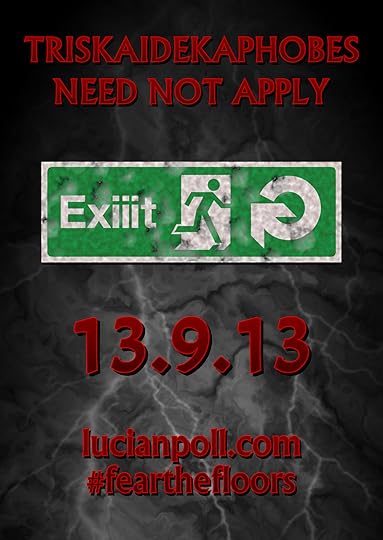 How do, horror fans, and welcome once more to my darkened corner of the internet. If you’ve arrived here on the back of my teaser advert in Scream magazine then come on in and make yourself at home. The teaser ad is for a novel of mine called The Floors, which will be released on Friday 13th September 2013. If you have ever wanted to know what it’s like to be trapped in a maze of thirteenth floors then stay tuned! (You can also see my previous post for a gander.)
How do, horror fans, and welcome once more to my darkened corner of the internet. If you’ve arrived here on the back of my teaser advert in Scream magazine then come on in and make yourself at home. The teaser ad is for a novel of mine called The Floors, which will be released on Friday 13th September 2013. If you have ever wanted to know what it’s like to be trapped in a maze of thirteenth floors then stay tuned! (You can also see my previous post for a gander.)
At the moment, however, you find me at a crucial stage of getting The Floors out there and into your hands – that of obtaining some feedback from test readers.
Skim through the acknowledgements section of a novel and you will often find the author thanking assorted friends, colleagues and peers for having read early drafts of their story. Now, unless you are a staggeringly gifted wordsmith and storyteller, with preternatural powers to shape the literary world with your expertly-crafted prose, then getting some early feedback is going to be a vital part of your writing process too, and doubly so when it comes to self-published work.
Why? Well, in the broadest terms, you wouldn’t want to sully your good name, assumed or otherwise, by peddling a shitty story riddled with errors. You aren’t going to get very far disrespecting readers like that. And if, like me, you are trying to make a name for yourself in the noisy world of self-publishing, then only your best work will do. Anything less and you are shooting all that writerly ambition of yours in the arse.
Hemingway, that hoary old source of a thousand and one tiresome Facebook quotes*, once said “The most essential gift for a good writer is a built-in, shockproof, shit detector.” This, of course, is true, but it isn’t a bad idea to also place your masterpiece under the noses of a couple of test readers.
(* For Neil Gaiman Facebook quotes, you can safely up that number to approximately 5.7 bazillion.)
Putting your work out for a test read can be a valuable experience, but you’ve got to go about it the right way. (Asking the opinion of a loved one, for example, really isn’t going to cut it. They will likely spare you the hurt of pointing out where your story stinks, but if they do rip into your story then the chances are they won’t be a loved one for much longer.)
So, some ground rules. First and foremost, take any pride you may have accumulated in creating your masterpiece and swallow it down hard. What you are looking for in a test read is an honest appraisal of your work. You’ll want to know where readers became frustrated with your story. You’ll want to know when a paragraph you rewrote fifty-odd times now reads with all the coherence of a Scrabble board. In short, you want to know where you can improve your story before you put it out there for real, be that for download, or in the hands of an agent/publisher. If you are simply seeking praise for your efforts then there are plenty of parasitic review sites that’ll gush as many superlatives your way as your credit card can handle.
Second, be sure to seek test readers that are sympathetic to the genre in which you are writing. You wouldn’t, for example, ask readers of The People’s Friend to test read American Psycho. (Actually, I probably would. Welcome to my sense of humour, world!) If at all possible seek critiques from fellow writers, the more published the better, and the opinions of those readers who devour novels like they’re going out of fashion. If you find a local writers group then bite your lip, develop a thick skin and jump on in. Otherwise there are plenty of reader’s groups on sites like Goodreads who you could tempt with a test read. Don’t spam forums, though. That only brings the banhammer down on your head, and rightly so. Respect the rules and ask for help politely.
Third, and this is crucial, remember at all times that your test readers are the ones helping you. They could just as easily be reading someone else’s story, but they have taken time out to read yours. Be heartened, because you know at least your story has a decent hook. Be thankful, and at least consider sending your readers a signed copy of the finished book. Give them a high-five in the acknowledgements. After all, it’s a pretty cool feeling to hold something in which you gave a helping hand.
The feedback you receive will vary. You just have to browse through the reviews on Amazon and Goodreads to see how different people like different things. What I’ve looked for in the feedback I have received thus far are patterns. If I see someone praising a part of the story and another criticising it, then that’s largely fine – the tie goes to the writer, as Stephen King would have it. If, however, I see a majority negative opinion forming over part of the story then I know I’ve still got some work left to do. I would reiterate my first point at this juncture and remind you to not get pissy at the criticism. If someone doesn’t understand the story then don’t go tearing a strip from them – it’s a failure of your story to connect. It happens. Move on. Only worry if nobody gets it!
You may have guessed at this point that these words are as much for my own benefit as anyone’s. They’ve stood me well these last four or five weeks as I’ve paced a trench into my carpet and bitten pretty much all the skin from my fingers and thumbs. Whether my composure goes all to shit with the first bad review I receive is another matter! 
I hope this diverting little posting has entertained more than it has lectured. I’ll likely post a few more reviews while I slave over the final draft, but will then return with a few words on what a professional edit entails. I hope you can join me.
Laters ‘taters.
Tagged: beta readers, books, horror, novel, test readers, the floors, thirteen, writing, XIII








June 23, 2013
The Floors exists! I have proof!
What-ho, world, it’s your least humble servant, Mr Poll, here with another eEpistle for you all, you lucky, lucky people. (I’ll leave it up to you how to pronoune eEpistle.)
You find us all in a state of unburnished excitement here at Poll Towers for we have recently taken receipt of an initial proof of The Floors, and, whaddayaknow, it looks pretty damn fine! Mostly.
Here, take a goosey:
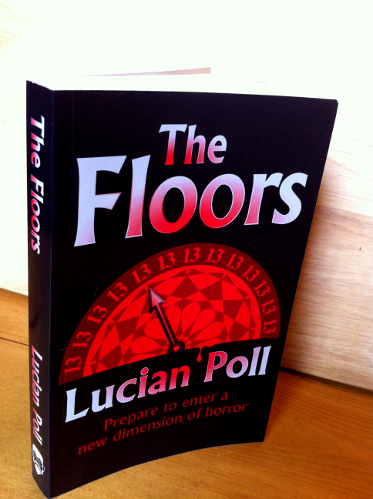 In my previous post, mention was made of using CreateSpace to produce the printed version of The Floors. If you are tempted to do the same with your pride and joy then this is the kind of result you can expect. Mighty fine, indeed, but then obviously I’d say that.
In my previous post, mention was made of using CreateSpace to produce the printed version of The Floors. If you are tempted to do the same with your pride and joy then this is the kind of result you can expect. Mighty fine, indeed, but then obviously I’d say that. 
There are, however, three things I would note:
1) CreateSpace books have glossy covers. If you want your finished book to have a smooth matt effect, like most UK trade paperbacks, then you may want to consider other print-on-demand services. (Same goes if you want to produce hardback versions.)
2) CreateSpace books offer a number of trim sizes, but nothing that seems to tally with UK trade paperbacks. For my 2p this isn’t a biggie, but may be something for you to bear in mind. (I believe CreateSpace have recently opened a UK print shop, however, so this might change in time.)
3) The glossy laminate seems to darken the cover image. Compare the snapshot above with the featured image of my previous post and you’ll see the printed copy loses most of the marble flash beneath the book’s title. It may be due to the large amount of black on my cover, but I suspect it may actually be the laminate. Either way, I’ll see if I can improve this before the release date.
Overall, though, I think you’d be chuffed with the results of print-on-demand. The quality impressed all who held the book in their hands. More than one person asked when they could see it on the shelves.
And there, I’m afraid, the bubble bursts.
If you dream only of seeing your book on the shelves of your local Waterstones, then CreateSpace is not the way to do it. Should Waterstones see CreateSpaces’s name on the ISBN record, they won’t touch the book. (I’ve asked.) The route to retail bookshelves is pretty much the same as it has been for centuries – find a publisher!
You may have better luck with a local independent bookseller, or one more sympathetic to genre fiction, such as Forbidden Planet. Expect your chances to remain slim, however. That said, I’ll fire off a few emails here and there, and will report back if I hear anything, positive or negative.
Anyway, moving on, and if you’ll forgive the insufferably-proud-parent vibe, here are a few more snaps of what you can expect in the printed copy. First, here’s how the book looks from behind:
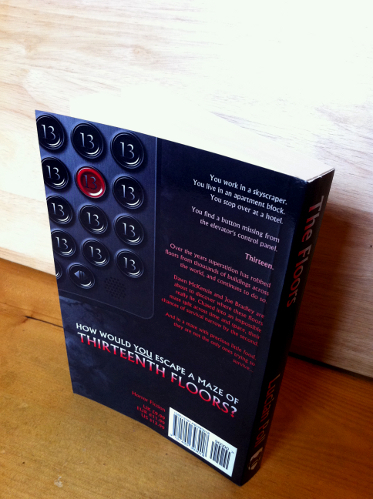 And here are a few snaps of the interior, including a few loosely-connected newspaper clippings, like the big tease I am.
And here are a few snaps of the interior, including a few loosely-connected newspaper clippings, like the big tease I am.
Here are the newspaper clippings in question:
(For those interested in how it was done, each clipping was constructed using Inkscape, then exported to a PNG file and a newsprint filter applied using GIMP. The results, I reckon, look pretty cool, and look good in the proof copy.)
So there you go. A relatively short posting this time, but one that I hope helps those of you who are tempted to try CreateSpace, or, even better, one I hope tempts you into dallying with The Floors! Thanks for tuning in. Do drop by again. I should have in the coming weeks something to report from the test reads. (Gulp!)
Laters, ‘taters.
Tagged: books, horror, novel, the floors, thirteen, writing, XIII








June 16, 2013
To ISBN, or not to ISBN?
 Hello there, internet! It’s your friendly neighbourhood horror writerly thing here with another wee posting for you.
Hello there, internet! It’s your friendly neighbourhood horror writerly thing here with another wee posting for you.
It’s like the eye of the storm here at Poll Towers at the moment. As mentioned in the previous post, the second draft of The Floors has been completed and now rests in the hands of a small team of test readers. It is also about to undergo surgery beneath John Jarrold’s red pen, which should really help the final draft slide into your eyeballs without touching the sides. Or something.
In the meantime, however, I’m caught in Limbo. I can’t really tinker with the story for another three or four weeks. At the same time I feel I cannot fully immerse myself in the planning and plotting of the next book. Oh, what’s an alter-ego to do?
To pass the time I’ve been trying to make myself useful: prettifying this here blog with a rather swish wallpaper (sorry, mobile browsers); also prettifying my Twitter page with lots of Floors-related goodness (again sorry, mobile browsers); adding a dedicated blog page for The Floors, which you can find via the menu strip above; adding a dedicated page for the book on Facebook… oh, and looking into International Standard Book Numbers, better known as ISBNs.
Yes, it’s rock ‘n roll 24 hours a day at Poll Towers! Pass the Werthers Originals, sonny.
Anyway, why ISBNs? Well, if you are keen to sell paperbacks and hardbacks in major book-buying territories then you probably won’t get terribly far without one. That odd-looking number, when plugged into a central database, tells wholesalers and retailers important information about the book, such as title, author, publisher… even the physical dimensions. (This is commonly and collectively referred to as the book’s ”metadata”.) It also gives the publisher all sorts of useful sales info as each ISBN passes through retailers’ tills. In short, ISBNs are the glue that holds together the often haphazard, flaky and wibbly-wobbly world of the printed book trade, and if you want to join the party then you’re going to need one.
As noted in previous posts, I will create both eBook and printed versions of The Floors. The printed copy will be produced through Amazon’s CreateSpace service, and for that I’d need an ISBN.
Now, when choosing your ISBN, CreateSpace do a bang-up job of confusing the hell out of people, at least if their forums are anything to go by. You can opt for a free ISBN that lists CreateSpace as the publisher. If, however, you have a block of your own unused ISBNs then you can use one of them instead. This lets you hide your self-published magnum opus behind a cool-sounding publisher’s name of your own making, such as Shit-yeah! Books or something. (CreateSpace also offers shades of ISBN that lists your own publisher’s name for plenty many dollars, but none of these services are available outside the US.)
So the question I faced was this: “Should I purchase my own block of ISBNs?”
It sounded like a pretty cool thing to do at the time. Having a title page that sported my own publisher’s logo would have given my book an air of respectability. Putting the logo on the spine would help make it look even more like a proper retail copy.
But then, after some thought, I came to the conclusion that that was pretty much the only positive to be had. In fact, putting my book out under Shit-yeah! Books could backfire if readers figure out it’s not actually a proper publishing house.
Then there was the cost of an ISBN. Nielsen will sell you a minimum block of 10 numbers for £126. Ouch! Then there was the information required as part of the ISBN application, namely my contact details. I certainly wasn’t keen on having my home address recorded in a widely-referenced database, so there was the additional expense of setting up a Royal Mail PO Box number – over £300 per year to have mail rerouted to my home address. Triple ouch!
Of course then it dawned on me what having an ISBN would actually entail. Yes, Shit-yeah! Books would be showing on the ISBN database alongside my sparkling new PO Box address, but then guess who would receive the orders? Yup. Me! I’d then have to get them printed through CreateSpace and shipped out to retailers, not to mention handling copes that don’t sell, or are misprinted.
All of a sudden I’d be three-quarters of the way towards becoming a proper publishing house! Now, yes, that sounds cool, but, truthfully, I only set out on this path to write stories, promote them here and there, and, hope upon hope, build a fan base.
So after taking into account all of that, the choice was easy. Going for an ISBN allocated by CreateSpace is by no means the end of the world. (It wouldn’t have taken long for readers to discover The Floors was self-published anyway, as I’ve been quite open about it here.)
Long post short, if you want to simply tell the damn story and hope it sells, I’d choose the free ISBN option from CreateSpace (or Smashwords, etc). If you are starting your own publishing empire and hope to use a service like CreateSpace to print your stock, then by all means apply for a block of your own ISBNs.
Well, that’s my take on the whole matter, anyway! I hope this has been of help, self-pubbers. If you do set up a publishing empire, remember little old Mr Poll, won’t you?
Right. Now to find something else to do! Laters, ‘taters.
Tagged: books, horror, ISBN, novel, the floors, thirteen, writing, XIII








June 2, 2013
So long, second draft! (And let the ads begin!)
Howdy, campers, it’s your favourite Lucian-Poll-named alter-ego here with a final view of The Floors’ second draft. You know, The Floors? Tut, tut, tut. I know I’ve been away a little while but even my memory isn’t that bad. (Actually it is. It’s a wonder I can still walk out of the house fully-clothed these days.)
Anyway, allow me to give you a quick recap of my most recent obsession:
“The one about thirteenth floors.” Yes, that’s the one. 
So in the last post I was having a fine old time ploughing through the middle third of the book and was looking forward to tackling the white-knuckle ride finale. Well, after a further 17 days I’m glad to say not only did I get the final third down but also a full read-through and a polish to boot, finishing two days ahead of schedule.
You know what that means? Yes! I’m free of The Floors for another six weeks! I can go to bed now and not have my mind whirring over plot complexities for three hours before sleep finally takes me! I can read other people’s stories again and forget about my own for a little while!
In short, my brain gets to recharge. I’ll have one final run-though of the manuscript starting 13th July 2013, but until then it’s time to rock n’ roll with the fun stuff again: artwork for this here blog, Facebook, Twitter, etc; supplementary materials for the printed copy, such as fake news stories; a much-delayed look at publishing through SmashWords; and also looking into the more admin-related stuff of being a self-publishing author. (ISBN numbers, anyone? Stay tuned, I may have something for you.)
In the meantime my story won’t be resting on its laurels. I am both thrilled and monumentally nervous to have quickly gathered a team of ardent horror fiction fans to put the story through its paces with a test read. I hope by the next post to have also secured super-agent John Jarrold’s services for a professional edit. Their combined findings will inform the work necessary come 13th July.
Regarding the edit, one of the aims was to get the word count under 100K. I failed, but only just, and that was mainly due to some cool new scenes that really had to go in. Another important aim was to trim away the fat of each sentence to make sure the reader doesn’t nod off before every full stop. If you’d like to know the rules I tried to follow here’s a brief rundown that may help your own projects:
My first draft had umpteen sentences dragged out with things like “could see”, “could feel” and “could sense”, when, really, most of the time, “saw”, “felt” and “sensed” worked just as well, especially in fast-flowing action scenes.
With perhaps one eye on NaNoWriMo word counts at the time, I found sentences in the first draft with entirely unnecessary lead-ins or lead-outs. Stuff such as “No sooner had XXX done YYY than…”. It takes a few reads of a sentence before you realise the thing works just as well when cut in half, but when you spot them it’s a good feeling.
Descriptions of thoughts and feelings. Such things often constituted “telling” and not “showing”, which puts an unnecessary and unwelcome degree of separation between the reader and the character. Many such descriptions of thoughts and feelings were therefore replaced with either lines of dialogue or actual thoughts.
That. There were way too many “thats” in the first draft. Same went for “had”. You’d be amazed how often you can get rid of these and not affect the meaning of a sentence. Most of them are therefore gone from the second draft.
Commas. Now, the grammarians out there are going to hate me for this, but I had the temerity to remove a lot of commas that, technically, ought to be there, particularly when listing things. (As for the Oxford comma, that can just bugger off for a start.) I only did this to help maintain a quick read. If the test reads and professional edit come back with a C- for such gross misconduct then I’ll reinstate them in the final draft. Hey, it’s not like I’m Cormac McCarthy, or anything. (More’s the pity.)
Moving on, I’m delighted to report that my adverts are starting to appear. Here’s the first for you:
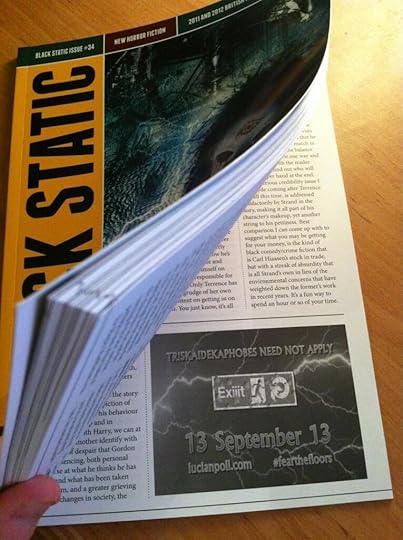
The first advert!
The “Exiiit” sign is a theme I’ve used in all the teaser ads to help convey the familiar yet otherworldly delights you’ll find in The Floors. (The lightning also plays a part.) You’ll see a larger version of this ad in Cemetery Dance issue 70, and a lightning-free (but cool full-colour) version in issue 19 of Scream Magazine. I’ll post piccies when I see them.
I must give a massive thank you to Andy Cox at TTA Press for placing the advert. Not only that but you can see quotes from my review of Spin by Nina Allan inside the current issues of both Black Static and Interzone, which is mondo cool, and really helps to establish Lucian Poll as a new name to perhaps look out for. It certainly made for a brilliant end to an otherwise typical Monday! I’ve said it before and I’ll keep on saying it: if you like a particular genre then hunt out and subscribe to dedicated magazines like Black Static, Interzone, Cemetery Dance, Albedo One, etc. You will almost certainly be turned onto new and varied voices in the field as a result and that can only be A Good Thing.
So on that note I’ll hop down from my soap box and will take my leave of you until next time. Many thanks for stopping by. Your continued readership is always appreciated, and I hope to see you in my next wee missive.
Now then, I’ve got approximately 0.998 British Libraries making up my to-be-read pile. Which hefty tome will it be? Hmm…
Tagged: books, editing, horror, novel, second draft, the floors, thirteen, writing, XIII









